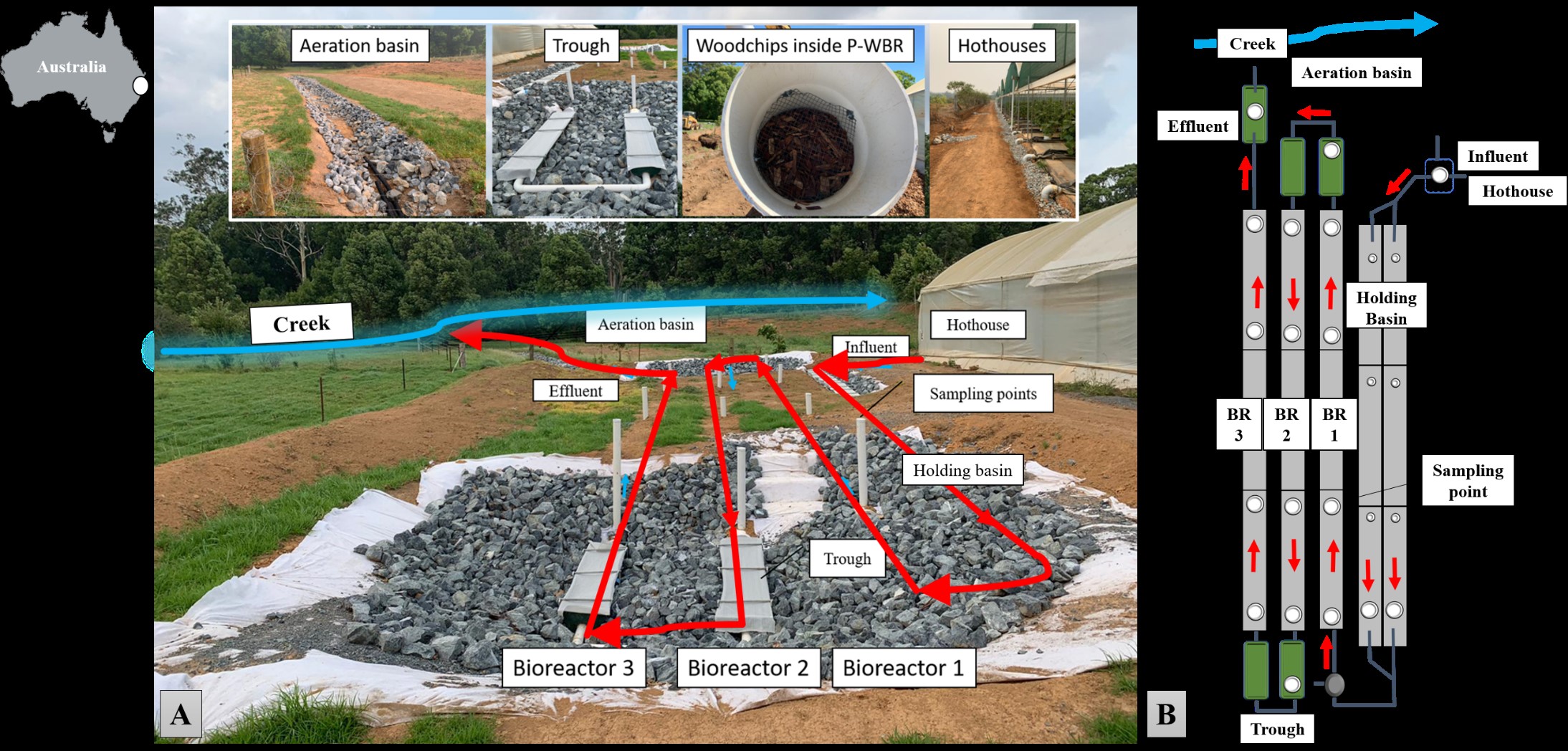Woodchip bioreactors may help farmers reduce fertiliser pollution in waterways
Categories
Share
/prod01/channel_8/media/scu-dep/news/images/2021/Cucumber-hothouse-with-mature-plants-credit-Shane-White-Southern-Cross-University-720px-720X475.JPEG)
Prototype woodchip bioreactors may reduce nitrogen pollution entering nearby waterways by as much as 85% in the right conditions, according to new studies by Southern Cross University.
While woodchip bioreactors have been used around the world, primarily to treat subsurface drainage, these new designs developed by North Coast Local Land Services can help reduce surface run-off from farms and have shown the highest ever nitrate removal rate recorded in a field bioreactor trial.
The Southern Cross University team collaborated with Coffs Harbour City Council and North Coast Local Land Services to test the new approach to minimise the problem.
The bioreactors were trialled in the Coffs Coast region where water quality is being affected by nitrogen pollution from expanding agricultural intensification like protected cropping (hothouse) and blueberry farm run-off. Drainage from these practices can enter streams without any treatment.
The two studies were led by the University’s PhD researchers Shane White and Praktan Wadnerkar, who are based at the National Marine Science Centre in Coffs Harbour.
Bananas, once a big industry in Coffs Harbour. Now the region produces more blueberries than anywhere else in Australia. Other crops like cucumbers are grown here too. To increase yield and boost plant health, farmers use fertilisers on these food crops. After heavy rain and flooding, untreated excess fertiliser, which has elevated nutrient levels, can cause algal blooms and create greenhouse gas emissions. That’s a problem because downstream, creeks and lakes drain into a really important habitat protection zone, the Solitary Islands Marine Park.
SHANE WHITE, PhD CANDIDATE, NATIONAL MARINE SCIENCE CENTRE: We’re from the National Marine Science Centre and we look at horticultural industry and the effect on waterways.
PRAKTAN WADNERKAR, PhD CANDIDATE, NATIONAL MARINE SCIENCE CENTRE: Agricultural intensification in the region is the culprit of elevated nutrient concentration in the creek.
Our research team is working with farmers, local council and the NSW government to try and mitigate these issues. One solution proving successful is bioreactor systems. Designed to act like a filter, the bioreactor catches excess nutrient run-off before it enters waterways. A large pit is dug in the ground and filled with woodchips. Bacteria, the tiny bugs that live in the soil, eat the carbon in the woodchips as well as the nitrogen in the run-off. The bacteria convert much of the nitrogen into a colourless, odourless and safe gas called di-nitrogen.
SHANE WHITE, PhD CANDIDATE, NATIONAL MARINE SCIENCE CENTRE: The nitrous oxide emissions produced from the bioreactor are far less than what happens naturally in fertilised soils. So these bioreactors cannot only reduce nitrogen coming into the creeks and downstream areas but also they can mitigate climate change.
STEPHEN CONRAD, PhD CANDIDATE, NATIONAL MARINE SCIENCE CENTRE: Large nitrous oxide emissions downstream of intense fertiliser use might be occurring in other horticultural regions of Australia and the world. This problem is in its infancy of being understood.
SHANE WHITE, PhD CANDIDATE, NATIONAL MARINE SCIENCE CENTRE: I think we all want to see sustainable environmental outcomes and also healthy crops. If we can achieve both of those, now we’re really on a winner.
“Our bioreactors stimulate bacteria to consume the nitrate as a food source by using woodchips as a substrate,” said Mr White, lead author of one of the reports.
“The woodchip bioreactors are designed to convert nitrate to the harmless di-nitrogen gas. Both bioreactors capture farm run-off, releasing lower nitrogen-laden water to the creek that would otherwise enter nearby waterways during rain events.”
Mr Wadnerkar, who authored the second report, said releasing untreated hothouse drainage creates a significant risk to local waterways.
“Drainage from the hothouses growing cucumbers can be up to 28,000 times higher than water quality guidelines,” said Mr Wadnerkar.
“We cannot allow those polluted waters to reach our creeks. While these are still prototype bioreactors, this collaboration has identified ways to improve the design to remove even more pollution. The bioreactors are another tool to improve nutrient management and environmental sustainability of farms if applied at scale.”
Mr White and Mr Wadnerkar emphasised that pollution prevention is still the best option and recommend the industry continue to reduce on-farm nitrogen use to prevent ongoing environmental losses.
“It is far more preferable that land managers actively reduce their fertiliser use. Bioreactors can be effective but represent an additional cost to reduce pollution,” Mr White said.

Bioreactor concept diagram (credit Praktan Wadnerkar).
Shaun Morris, a report co-author, is the Senior Land Services Officer at North Coast Local Land Services.
“Farmers have been very willing to cooperate and give us access to their farms to perform these trials,” said Mr Morris.
“Our partnership with Southern Cross, Coffs Harbour City Council and farmers will continue to improve on-farm practices and provide options to protect our valuable waterways while maintaining agricultural productivity.”
Funding
The research project was funded by the Coffs Harbour City Council Environmental Levy Grants program.
Reports
The reports are available on the Coffs Harbour City Council website. Visit the Monitoring our waterways section:
- Improving water quality downstream of blueberry farms: trial of a novel surface-flow bioreactor design by Shane White et al, January 2021
- Improving Water Quality Downstream of Protected Cropping Operations (Hothouses) by Praktan D Wadnerkar et al, January 2021
Landline
Learn more. Our researchers work was showcased in this ABC Landline story Farm Bioreactors: Controlling nitrogen run-off from blueberry farming
Media contact: Sharlene King, media office at Southern Cross University, 0429 661 349 or scumedia@scu.edu.au

/prod01/channel_8/media/scu-dep/current-students/images/Coffs-harbour_student-group_20220616_33-147kb.jpg)
/prod01/channel_8/media/scu-dep/current-students/services/counselling/images/RS21533_English-College-Student_20191210_DSC_6961-117kb.jpg)
/prod01/channel_8/media/scu-dep/study/scholarships/images/STEPHANIE-PORTO-108-2-169kb.jpg)
/prod01/channel_8/media/scu-dep/study/arts-and-humanities/images/RS20958_Chin-Yung-Pang-Andy_20190309__79I5562-960X540.jpg)
/prod01/channel_8/media/scu-dep/experience/images/SCU-INTNL-STUDY-GUIDE-280422-256-72kb.jpg)
/prod01/channel_8/media/dep-site-assets/component-library/screenshots/online-1X1.jpg)
/514x0:1487x973/prod01/channel_8/media/scu-dep/news/images/2025/Bruce-Thom-w-Chris-Klaas-and-Muhammad-Islami_2025-Nov-credit-East-Coast-Conferences---Copy.jpg)
/514x0:1487x973/prod01/channel_8/media/scu-dep/news/images/2025/Coral-larvae-seedbox-dye-Credit-G-Carlin_CSIRO-2000X973.JPG)
/258x0:1290x1032/prod01/channel_8/media/scu-dep/news/images/2025/7---Southern-Cross-University-researcher-project-lead-Professor-Scott-Johnston-by-the-Clarence-river-holding-the-sediment-sample-bucket..jpg)
/514x0:1487x973/prod01/channel_8/media/scu-dep/news/images/2025/lead-smelters-on-coastline-of-Port-Pirie-in-South-Australia_Shutterstock_1976291291-2000X973.jpg)
/514x0:1487x973/prod01/channel_8/media/scu-dep/news/images/2025/Lead-hazard-sign-for-fuel_credit-Kevin-Bidwell-on-Pexels-1309553-2000X973.jpg)
/514x0:1487x973/prod01/channel_8/media/scu-dep/news/images/2025/Chelsea-Waters-at-Lizard-Island_20211124_08-CREDIT-Southern-Cross-University-2000X973-copy.jpg)
/762x0:2205x1443/prod01/channel_8/media/scu-dep/news/images/2025/Amanda-Philp-w-green-sea-turtle-at-ASTR-1000032539-credit-ASTR-2000X973-edit.jpg)
/334x0:1667x1333/prod01/channel_8/media/scu-dep/news/images/2025/Philoria_Kundagungan_-SCU-GRASP.jpg)
/334x0:1667x1333/prod01/channel_8/media/scu-dep/news/images/2025/paul-hanaoka-w2DsS-ZAP4U-unsplash.jpg)
/438x0:1563x1125/prod01/channel_8/media/scu-dep/news/images/2025/pexels-allen-tang-2404192-4056629.jpg)